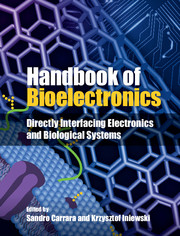Book contents
- Frontmatter
- Contents
- List of Contributors
- 1 What is bioelectronics?
- Part I Electronic components
- Part II Biosensors
- Part III Fuel cells
- Part IV Biomimetic systems
- 18 Biomimetic systems
- 19 Epidermal electronics – flexible electronics for biomedical applications
- 20 Bioelectronics brain using memristive polymer statistical systems
- 21 Electronic modeling of synthetic genetic networks
- Part V Bionics
- Part VI Brain interfaces
- Part VII Lab-on-a-chip
- Part VIII Future perspectives
- Index
- References
20 - Bioelectronics brain using memristive polymer statistical systems
from Part IV - Biomimetic systems
Published online by Cambridge University Press: 05 September 2015
- Frontmatter
- Contents
- List of Contributors
- 1 What is bioelectronics?
- Part I Electronic components
- Part II Biosensors
- Part III Fuel cells
- Part IV Biomimetic systems
- 18 Biomimetic systems
- 19 Epidermal electronics – flexible electronics for biomedical applications
- 20 Bioelectronics brain using memristive polymer statistical systems
- 21 Electronic modeling of synthetic genetic networks
- Part V Bionics
- Part VI Brain interfaces
- Part VII Lab-on-a-chip
- Part VIII Future perspectives
- Index
- References
Summary
Realization of bio-inspired computational systems demands elements that will be used for both memorizing and processing of the information, as occurs in the brain. In this chapter we will consider organic memristive devices – elements that were designed and constructed for mimicking the most important property of synapses, responsible for so-called Hebbian learning. The organization of the device and its important properties are considered. Its utilization in generators of auto-oscillation generators and in logic elements with memory is also considered. Finally, stochastic networks of organic memristive devices have demonstrated several similarities with learning of brains of animals and humans.
Introduction
A significant difference in the architecture of computers and the brain is that in the computer the memory and the processor are different devices with no influence on each other. The information in this case plays a passive role – it can be recorded, accessed, canceled, but it does not vary properties of the system. In the brain, in contrast, the same elements are used for both memorizing and processing of the information. This architecture allows learning of the system at a hardware level. Information begins to play an active role: it is not only recorded, but it varies connections within the processor, preparing it for more effective resolving of similar tasks in the future. The other essential difference between the brain and computer is the fact that in the brain we have highly parallel information processing. This is why it is much more effective for some tasks, such as, for example, the recognition and classification of objects.
- Type
- Chapter
- Information
- Handbook of BioelectronicsDirectly Interfacing Electronics and Biological Systems, pp. 256 - 265Publisher: Cambridge University PressPrint publication year: 2015
References
- 3
- Cited by



